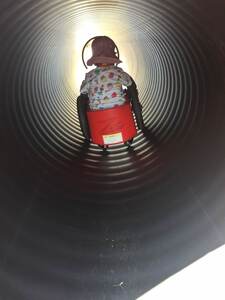Thank you for signing, we have been so encouraged by the support we have received over the last few days. It is so important that more people become aware of the issue of inaccessibility within the community. I have since read about the Community Participation Bill initiated by Senator John Dolan in June 2019, which outlines exactly what we are striving for with respect to playgrounds being designed with a universal design in mind. Families and advocates before us have already done the hard work of bringing the matter before the Seanad. Unfortunately the Bill lapsed with the dissolution of the Seanad and the Dáil this March. Now more than ever, I feel we need to ensure our children are not forgotten about. We will keep highlighting the issue and will be watching for movement on the Bill closely. Our plan for now, in light of the pandemic, will be visiting playgrounds in Louth as we have been informed by Louth CoCo that 'the majority of these are accessible throughout the county.'
To: TDs, Local Authorities, Coillte
Make Play and Leisure Spaces Accessible

Make playgrounds and public recreational areas and amenities wheelchair accessible.
Why is this important?
I am writing to you today as a primary school teacher, and more importantly as a mother of two young boys who are disabled. My four year old is a full-time wheelchair user and we are unsure yet as to whether his younger brother will also require a wheelchair. My boys are both bright, intelligent, inquisitive children who are highly sociable. In light of current events during this pandemic, I have seen so many parents and teachers discuss how this may impact our kids and the overwhelming consensus amongst us all have been concerns regarding the possible implications on their social development as they cannot play with their friends, explore nature, play freely and make new friends at local playgrounds etc.
It has really made me stop and think as these have been ongoing concerns of mine due to our sons’ mobility needs. The truth of it is, we have found it very difficult to find playgrounds where Oscar can play. As well as not having any wheelchair friendly equipment for use, many playgrounds have completely inaccessible ground coverings like tree bark. I’m a firm believer that if I have an issue with something, I will try to offer alternative suggestions in order to help resolve said issue. A simple Google image search for ‘wheelchair friendly activities in playground’ yields a plethora of equipment that is accessible not only for users of wheelchairs, walkers and buggies, but also for children without disabilities. Slieve Gullion Forest Park is close to where we live and would be the best we have experienced. It’s not lost on me that this particular playground is in Northern Ireland, where the UK has much stricter protocol for accessible planning regulations. Within my local area in recent times, I’ve seen two new playgrounds built, one completely inaccessible to wheelchairs due to the bark surfaces and use of steep hills in its designs. It absolutely baffles me how in these times when we are seemingly a progressive country, that we completely omit the needs and right to play of a whole category of children. We teach inclusion and diversity in our schools every day, yet when this is not practised by our leaders, it is unforgiveable. We cannot accept this as an oversight any longer, we cannot accept the meagre list of accessible playgrounds dotted few and far between across the entire country. There is very little opportunity for a family to engage in a spontaneous stop-off at the playground when the statistics show that the playground will more than likely be inaccessible for the disabled child. Accessibility needs to be engrained within everything we plan for our public spaces. Untold damage is being done to our disabled children when they are being excluded and made to feel less than in their own hometowns.
- Article 31 of the UN Convention on the Rights of the Child states that: “Every child is entitled to rest and play and to have the chance to join in a wide range of activities including cultural and artistic activities.”
- Article 30(5d) of the UN Convention on the Rights of Persons with Disabilities states that “children with disabilities should have equal access with other children to participation in play, recreation and leisure and sporting activities, including those activities in the school system.”
Outdoor natural areas are another area which raise accessible issues within the disability community. I can only speak from my own experience, as an avid nature lover and mother to two children with mobility needs. I understand that the natural world is best left to its own devices and can be highly inaccessible. However, a lot of our natural amenities that are open to the public have some sort of surface laid down as a path for the public to use. Why not go one step further and make sure that surface is also wheelchair friendly? The choice of what gravel is used can make all the difference for wheelchair users’ accessibility. The Irish Wheelchair Association has published a guide called The Great Outdoors which provides excellent detail.
As an island country, our beaches are areas of beauty which everyone should be able to access, and not just from the side-lines. Beach wheelchairs are available at some sites, but not nearly enough, particularly at times of the year when they are in high demand. Availability of sand mats such as Access Trax would open up access immensely. “Foldable, lightweight, portable pathways for accessibility over outdoor terrain” would allow wheelchair users to roll right onto the beach as well as walking mobility aids, buggies and prams.
- Article 30 of the UN Convention on the Rights of Persons with Disabilities recognises that disabled people should “Enjoy access to places for cultural performances or services, such as theatres, museums, cinemas, libraries and tourism services, and, as far as possible, enjoy access to monuments and sites of national cultural importance.”
As an educator and a parent, all I want is for my children to be allowed every and equal opportunity to thrive and make their mark on the world. I am available for any discussion should you wish, but I would ask you to note that I am just one voice of many. My voice pertains to my experience as a parent of my disabled children. There are many voices of other parents , but most importantly voices of disabled adults who have lived through experiences of being excluded and treated differently and unfairly. This is only one area of accessibility we have come up against, and unfortunately, I am not naïve enough to hope that it is our last.
It has really made me stop and think as these have been ongoing concerns of mine due to our sons’ mobility needs. The truth of it is, we have found it very difficult to find playgrounds where Oscar can play. As well as not having any wheelchair friendly equipment for use, many playgrounds have completely inaccessible ground coverings like tree bark. I’m a firm believer that if I have an issue with something, I will try to offer alternative suggestions in order to help resolve said issue. A simple Google image search for ‘wheelchair friendly activities in playground’ yields a plethora of equipment that is accessible not only for users of wheelchairs, walkers and buggies, but also for children without disabilities. Slieve Gullion Forest Park is close to where we live and would be the best we have experienced. It’s not lost on me that this particular playground is in Northern Ireland, where the UK has much stricter protocol for accessible planning regulations. Within my local area in recent times, I’ve seen two new playgrounds built, one completely inaccessible to wheelchairs due to the bark surfaces and use of steep hills in its designs. It absolutely baffles me how in these times when we are seemingly a progressive country, that we completely omit the needs and right to play of a whole category of children. We teach inclusion and diversity in our schools every day, yet when this is not practised by our leaders, it is unforgiveable. We cannot accept this as an oversight any longer, we cannot accept the meagre list of accessible playgrounds dotted few and far between across the entire country. There is very little opportunity for a family to engage in a spontaneous stop-off at the playground when the statistics show that the playground will more than likely be inaccessible for the disabled child. Accessibility needs to be engrained within everything we plan for our public spaces. Untold damage is being done to our disabled children when they are being excluded and made to feel less than in their own hometowns.
- Article 31 of the UN Convention on the Rights of the Child states that: “Every child is entitled to rest and play and to have the chance to join in a wide range of activities including cultural and artistic activities.”
- Article 30(5d) of the UN Convention on the Rights of Persons with Disabilities states that “children with disabilities should have equal access with other children to participation in play, recreation and leisure and sporting activities, including those activities in the school system.”
Outdoor natural areas are another area which raise accessible issues within the disability community. I can only speak from my own experience, as an avid nature lover and mother to two children with mobility needs. I understand that the natural world is best left to its own devices and can be highly inaccessible. However, a lot of our natural amenities that are open to the public have some sort of surface laid down as a path for the public to use. Why not go one step further and make sure that surface is also wheelchair friendly? The choice of what gravel is used can make all the difference for wheelchair users’ accessibility. The Irish Wheelchair Association has published a guide called The Great Outdoors which provides excellent detail.
As an island country, our beaches are areas of beauty which everyone should be able to access, and not just from the side-lines. Beach wheelchairs are available at some sites, but not nearly enough, particularly at times of the year when they are in high demand. Availability of sand mats such as Access Trax would open up access immensely. “Foldable, lightweight, portable pathways for accessibility over outdoor terrain” would allow wheelchair users to roll right onto the beach as well as walking mobility aids, buggies and prams.
- Article 30 of the UN Convention on the Rights of Persons with Disabilities recognises that disabled people should “Enjoy access to places for cultural performances or services, such as theatres, museums, cinemas, libraries and tourism services, and, as far as possible, enjoy access to monuments and sites of national cultural importance.”
As an educator and a parent, all I want is for my children to be allowed every and equal opportunity to thrive and make their mark on the world. I am available for any discussion should you wish, but I would ask you to note that I am just one voice of many. My voice pertains to my experience as a parent of my disabled children. There are many voices of other parents , but most importantly voices of disabled adults who have lived through experiences of being excluded and treated differently and unfairly. This is only one area of accessibility we have come up against, and unfortunately, I am not naïve enough to hope that it is our last.
